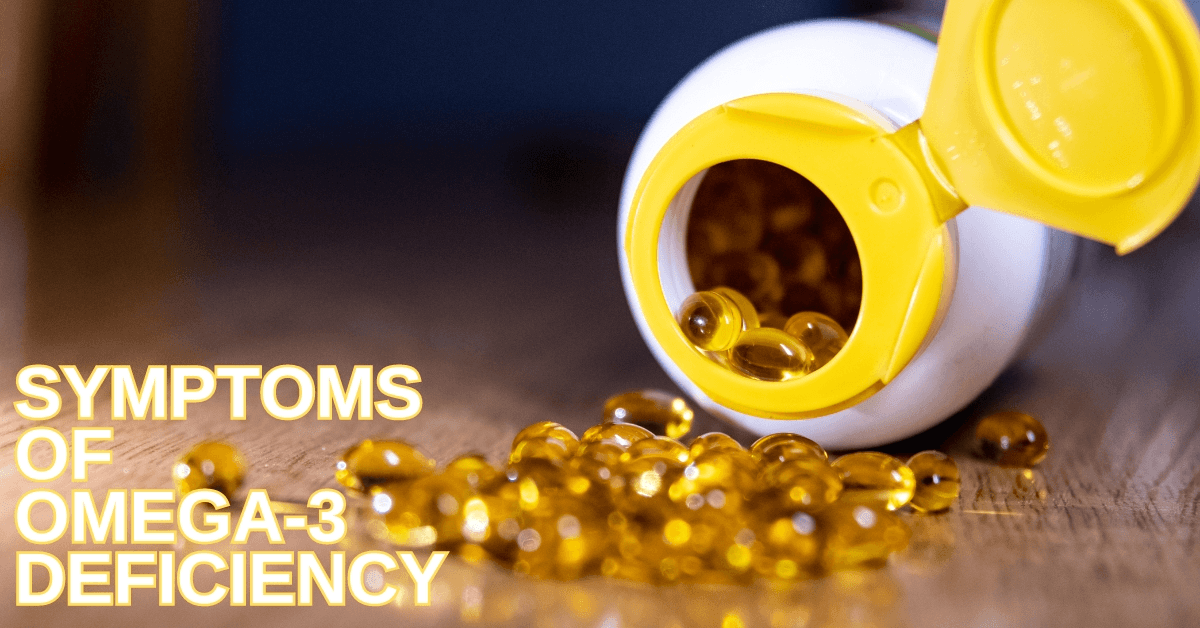Symptoms Of Omega-3 Deficiency
Symptoms Of Omega-3 Deficiency: What To Look For
Omega-3 fatty acids are essential for many body processes, and a lack of them can cause symptoms to become apparent.
Dry skin, brittle hair and nails, exhaustion, impaired memory, mood swings, and sadness are typical signs of an omega-3 deficit.
People may also have trouble concentrating, suffer from joint pain, and have a higher chance of developing heart disease. Including foods high in omega-3s, such as walnuts, flaxseeds, and seafood, can help reduce these symptoms.
However, if signs of deficiency continue, it is advised to seek the opinion of a healthcare provider for individual guidance and possible supplementation.
Frequent use of omega-3 supplements can help lessen the symptoms associated with deficiencies.
Omega-3 Deficiency Signs
The symptoms of omega-3 deficiency include dry skin, brittle hair and nails, fatigue, poor memory, mood swings, depression, etc.
Let’s explore some common symptoms of omega-3 deficiency:

1. Dry Skin
Dry skin is a common sign of omega-3 deficiency, attributed to inadequate levels of essential fatty acids.
Omega-3 fatty acids, particularly EPA and DHA, play a crucial role in maintaining skin health by supporting its natural barrier function and regulating oil production.
When deficient in omega-3s, the skin’s barrier becomes compromised, increasing water loss and dryness.
This can manifest as rough, flaky, or itchy skin, often accompanied by redness or irritation. Incorporating omega-3-rich foods into the diet can help restore skin hydration, improve overall health, and promote smoother skin.
2. Brittle Hair
Brittle hair is a significant indicator of omega-3 deficiency, stemming from insufficient levels of essential fatty acids crucial for maintaining hair health.
Omega-3 fatty acids, notably EPA and DHA, play pivotal roles in nourishing hair follicles and promoting strength, elasticity, and shine.
When deficient in omega-3s, hair becomes dry, brittle, and prone to breakage. Additionally, inadequate omega-3 levels can lead to a lacklustre appearance, with hair losing its natural lustre and vitality.
Incorporating omega-3-rich foods into the diet can help replenish these essential fatty acids, supporting hair health from within and restoring its strength and overall vibrancy.

3. Fatigue
Fatigue is a significant symptom of omega-3 deficiency. These fatty acids play a role in energy production and overall vitality.
Omega-3 fatty acids, particularly EPA and DHA, contribute to the efficient functioning of cell membranes, aiding in transporting nutrients and oxygen to cells throughout the body.
When omega-3s are deficient, cellular processes may become compromised, leading to decreased energy levels and increased feelings of tiredness or lethargy.
Additionally, omega-3 deficiency can impair the body's ability to regulate inflammation, further contributing to fatigue. Incorporating omega-3-rich foods into the diet can help to alleviate fatigue symptoms.
4. Poor Memory
Poor memory can be a significant symptom of omega-3 deficiency due to these fatty acids' crucial role in brain health and cognitive function.
Omega-3 fatty acids, EPA and DHA, are essential for maintaining the structure and functionality of brain cells, especially those involved in memory creation and retrieval.
When deficient in omega-3s, individuals may experience difficulty concentrating, learning, and memory recall.
A higher risk of age-related cognitive decline and neurodegenerative illnesses has also been linked to low omega-3 levels. Incorporating omega-3-rich foods helps to improve memory function.

5. Mood Swings
Since omega-3 fatty acids are essential for brain function and control, mood swings may indicate an omega-3 shortage.
Omega-3 fatty acids, EPA and DHA, are essential for the brain's cell membranes to remain intact and neurotransmitter signalling pathways to function properly.
A lack of omega-3 fatty acids can cause abnormalities in the neurotransmitters that control mood, which can cause irritability, mood swings, and even signs of anxiety or despair.
Research suggests that supplementing with omega-3 fatty acids may help reduce mood disorders and enhance mental health in general.
6. Depression
Omega-3 insufficiency has been related to depression because neurotransmitter function and brain health depend on these important fatty acids.
Omega-3 fatty acids, particularly EPA and DHA, are essential for preserving the integrity of cell membranes and supporting neurotransmitter signalling pathways related to mood regulation.
People who are low in omega-3 fatty acids may have abnormalities in neurotransmitters such as dopamine and serotonin, which are important for mood regulation.
Studies indicate that omega-3 supplementation may help reduce depressive symptoms and enhance mental health, highlighting the importance of consuming enough of these vital nutrients to maintain cognitive health.
7. Joint Pain
Due to its essential role in lowering inflammation throughout the body, including the joints, omega-3 insufficiency may be indicated by joint discomfort.
When omega-3 fatty acids, such as EPA and DHA, have anti-inflammatory qualities, pro-inflammatory molecules that cause joint pain and stiffness are produced less frequently.
A lack of omega-3 fatty acids might cause increased joint inflammation, which can cause pain and limited movement.
Providing enough nutrients for joint health and wellness is imperative. Studies indicate that omega-3 fatty acid supplementation can mitigate joint discomfort and improve joint performance.

8. Difficulty Concentrating
Omega-3 fatty acids are necessary for the brain's proper operation, including focus and attention, so difficulty concentrating could indicate an omega-3 shortage.
Particularly EPA and DHA, omega-3 fatty acids maintain brain cell shape and function by supporting neurotransmitter signalling pathways essential for cognitive functions.
Omega-3 fatty acid deficiencies can cause neurotransmitter dysfunction, making it harder for people to focus, pay attention, and process information.
Studies indicate that taking omega-3 fatty acids supplements may enhance cognitive function, highlighting the significance of sufficient consumption of these nutrients for the best possible brain health and cognitive function.
9. An Increased Risk Of Heart Disease
Omega-3 deficiency may raise the risk of heart disease because these vital fatty acids are important for cardiovascular health.
Consuming omega-3 fatty acids, especially EPA and DHA, can partly prevent heart disease. They can help lower blood triglyceride levels, reduce inflammation, and enhance cardiac rhythm.
In addition to having greater triglyceride and inflammatory levels, people who are omega-3 deficient are also more likely to acquire illnesses like atherosclerosis, hypertension, and coronary artery disease.
Including foods high in omega-3 fatty acids can help reduce these risks and support heart health.
10. Vision Problems
Vision problems can be a significant symptom of omega-3 deficiency, as these fatty acids are essential for maintaining optimal eye health.
Omega-3 fatty acids, particularly DHA, are abundant in the retina and are crucial in supporting its structure and function.
When deficient in omega-3s, individuals may experience symptoms such as dry eyes, blurry vision, and difficulty adjusting to darkness.
A higher risk of age-related macular degeneration and other vision-related disorders is also connected to insufficient omega-3 levels.
Eating a diet high in foods high in omega-3 fatty acids supports eye health and lowers the chance of visual issues.

11. Brittle Nails
Brittle nails are a prominent symptom of omega-3 deficiency, indicative of insufficient essential fatty acids vital for nail health.
Omega-3 fatty acids like EPA and DHA nourish and fortify the nail bed, preserving its integrity.
Without an adequate omega-3 supply, nails become dry, fragile, and prone to splitting or breaking easily.
Additionally, omega-3 deficiency may lead to slow nail growth and a dull, uneven appearance. Incorporating omega-3-rich foods into the diet can help promote stronger, healthier nails.
12. Impaired Immune Function
Impaired immune function is a symptom of omega-3 deficiency, as these fatty acids are excruciating in the immune response.
Omega-3 fatty acids, especially EPA and DHA, help modulate inflammation and support the production of immune cells, enhancing the body’s ability to fight off infections and diseases.
People who don't get enough omega-3 fatty acids may have compromised immune systems, making them more vulnerable to allergies, autoimmune diseases, and infections.
Additionally, inadequate omega-3 levels have been associated with chronic inflammation, which can further compromise immune function.
Ensuring sufficient intake of omega-3-rich foods is essential for maintaining a robust immune system.
How To Improve Omega-3 Status
Improving omega-3 status can be achieved through dietary changes and supplementation. Let’s explore some tips to learn how to improve omega-3 status:

1. Enhancing Omega-3 Intake
Incorporating fatty fish like salmon, mackerel, and sardines into your diet regularly is a key strategy to boost omega-3 status.
This fish is rich in the vital omega-3 fatty acids EPA and DHA, which are important for general health.
To guarantee a proper intake of omega-3s, try to incorporate them into your meals at least twice or thrice a week.
Try experimenting with new cooking techniques and dishes to keep meals interesting and diverse.
Additionally, pairing fatty fish with colourful vegetables and whole grains can enhance nutrient intake while supporting overall well-being and maintaining a healthy omega-3 balance.
2. Plant-Based Source
To elevate omega-3 status, integrate plant-based sources rich in these fatty acids into your diet. Flaxseeds, chia seeds, walnuts, and hemp seeds are excellent choices.
Incorporate them into smoothies, salads, yogurt, or oatmeal for a nutrient-packed boost. Adding ground flaxseeds or chia seeds to baked goods or homemade energy bars can also enhance omega-3 intake.
Consider sprinkling walnuts or hemp seeds over meals or snacks for an extra omega-3 punch. These plant-based options offer versatility and nutritional benefits, making them convenient additions to support overall health and maintain optimal omega-3 levels.

3. Fish Oil
Supplementing with fish oil capsules is a convenient way to increase omega-3 status, offering concentrated doses of EPA and DHA.
Select supplements from reputable brands known for their quality to ensure purity and potency. Speaking with a healthcare provider is imperative to find the right dosage based on a person's needs and health goals.
To enhance absorption, incorporate fish oil capsules into your daily routine, preferably with meals. Regular supplementation can help bridge the gap between dietary intake and omega-3 requirements, especially for those with limited access to fatty fish.
Remember to store supplements properly and adhere to recommended dosages for optimal benefits.
4. Meat And Dairy Products
Choosing grass-fed meat and dairy products is a smart strategy to boost omega-3 status. Compared to conventionally raised counterparts, grass-fed options typically contain higher omega-3 fatty acids, particularly EPA and DHA.
Look for labels indicating grass-fed or pasture-raised when shopping for meat, poultry, eggs, and dairy products.
Incorporate these nutrient-rich options into your meals regularly to increase omega-3 intake while enjoying the benefits of higher-quality, more sustainably sourced foods.
By prioritizing grass-fed options, you can support your health and environmental sustainability.

5. Fortified Foods
Selecting omega-3-fortified foods, such as specific brands of eggs, milk, and yogurt, can be a simple way to enhance omega-3 status.
These fortified products are enriched with EPA and DHA, providing an additional source of these essential fatty acids in your diet.
When shopping, look for labels indicating omega-3 enrichment or fortification. Incorporate these fortified foods into your daily meals and snacks to increase omega-3 intake without significantly changing your routine.
To enjoy these convenient benefits, pair omega-3-fortified yogurt with fruit for breakfast or use omega-3-enriched milk in smoothies.
6. Fortified Cooking Oil
Opting for cooking oils rich in omega-3s, such as flaxseed or canola oil, can elevate your omega-3 status.
These oils offer a healthier alternative to those high in omega-6 fatty acids, helping rebalance your omega-3 to omega-6 ratio.
Use flaxseed or canola oil for salad dressings, drizzling over cooked vegetables, or light sautéing to preserve their omega-3 content.
Incorporating these oils into your cooking routine boosts omega-3 intake, promotes heart health, and reduces inflammation. Switch to omega-3-rich oils to support overall well-being and maintain optimal omega-3 levels.
7. Balancing Omega-3 And Omega-6
The key to maximizing omega-3 status and general health is maintaining a balanced ratio of omega-3 to omega-6.
The necessary fatty acids omega-3 and omega-6 are typically overindulged in Western diets, which might hinder the absorption of omega-3 fatty acids and worsen inflammation.
To improve omega-3 status, focus on increasing your intake of omega-3-rich foods while reducing your intake of processed and fried foods high in omega-6s.
Incorporate sources of omega-3s like fatty fish, flaxseeds, and walnuts into your diet while minimizing consumption of vegetable oils high in omega-6s.

8. Seafood
Experimenting with seafood recipes offers a delicious way to boost omega-3 status by incorporating a variety of nutrient-rich options into your meals.
Explore diverse fish varieties like salmon, trout, and sardines, each packed with EPA and DHA omega-3 fatty acids.
Try broiling, baking, or grilling fish with aromatic herbs and spices for a wholesome and filling supper.
Incorporate seafood into salads, stir-fries, or pasta dishes to add omega-3s to your diet while enjoying diverse flavours and textures.
By embracing seafood in your culinary repertoire, you can effortlessly elevate your omega-3 intake.
9. Algae Based Supplements
For vegetarians or vegans, incorporating algae-based supplements into your routine offers a valuable alternative source of omega-3s.
Algae supplements provide EPA and DHA, the essential fatty acids typically found in fish, making them an ideal option for those following plant-based diets.
Include algae-based supplements in your daily regimen to ensure sufficient omega-3 intake and support overall health.
For advice on the right dosage, depending on your requirements and dietary choices, speak with a healthcare provider. You can significantly increase your omega-3 status by using supplements made from algae.
10. Avoid Processed Food
To bolster omega-3 status, minimize consumption of processed foods and snacks, which typically contain unhealthy fats and minimal omega-3s.
Instead, opt for whole, nutrient-rich foods like fruits, vegetables, nuts, and seeds, which naturally provide omega-3 fatty acids and other essential nutrients.
Lean proteins such as fish, chicken, and lentils should be incorporated into your meals, and whole grains should be preferred over refined grains.
When craving snacks, include omega-3-rich options such as mixed nuts, seeds, or yogurt with added flaxseeds.
By prioritizing whole foods over processed alternatives, you can enhance omega-3 intake while supporting overall health and well-being.

11. Avoid Alcohol
To optimize omega-3 status, avoid excessive alcohol intake and trans fats. Alcohol can affect the body's capacity to absorb and utilize omega-3 fatty acids.
Thus, it should only be consumed in moderation. Additionally, trans fats found in processed and fried foods can interfere with omega-3 metabolism and promote inflammation.
Instead, focus on whole, unprocessed foods rich in omega-3s, like fatty fish, flaxseeds, and walnuts.
Prioritize cooking methods such as baking, grilling, or steaming over frying to minimize trans fat consumption. By avoiding excessive alcohol and trans fats, you can enhance omega-3 absorption.
12. Counselling With Healthcare Professionals
They can assess your omega-3 levels, nutritional patterns, and health goals to provide tailored recommendations.
This may include dietary adjustments, supplementation, or lifestyle changes to optimize omega-3 intake and promote overall well-being.
A healthcare professional can address any underlying health conditions or medications affecting omega-3 absorption or utilization.
By collaborating with a qualified expert, you can develop a comprehensive plan to increase omega-3 status and effectively support your long-term health goals.
FAQ
1. How long does it take to cure omega-3 deficiency?
Answer: The time it takes to treat omega-3 insufficiency varies depending on a person's unique circumstances, including food, supplements, and general health.
With consistent consumption of omega-3-rich foods and supplements, improvement in symptoms can often be observed within a few weeks to a few months, but individual responses may vary.

Conclusion
In conclusion, recognizing and addressing symptoms of omega-3 deficiency are vital for overall health and well-being.
Dry skin, brittle hair and nails, exhaustion, and mood swings are frequent signs of a possible deficiency in essential fatty acids in the body.
Restoring omega-3 levels and mitigating symptoms of deficiency can be achieved by including foods high in omega-3s, such as walnuts, flaxseeds, and fatty fish, in the diet and, if needed, by supplementation.
Additionally, consuming trans fats and alcohol in moderation can help promote the absorption and utilization of omega-3 fatty acids.
Consulting with a healthcare professional ensures an effective recovery and promotes long-term omega-3 balance and optimal health.
I trust you enjoyed this article about the Symptoms Of Omega-3 Deficiency. Please stay tuned for more blog posts soon. Take care!
JeannetteZ
Your Opinion Is Important To Me
Do you have thoughts, ideas, or questions? I would love to hear from you. Please leave me your questions, experiences, and remarks about this article, Symptoms Of Omega-3 Deficiency, in the comments section below. You can also email me at Jeannette@Close-To-Nature.org.
Disclosure
This post may contain affiliate links. As an Amazon Associate and other affiliate programs, I earn from qualifying purchases at no extra cost to you. Please read my full affiliate disclosure.
You might also enjoy these blog posts:
Best Soil For Growing Vegetables
Best Ways To Prepare Soil For Fruit Trees
Best Soil To Use For Flowering Plants
Discover The Diversity: Species Of Owls In The World
Interesting Facts About Hummingbirds



